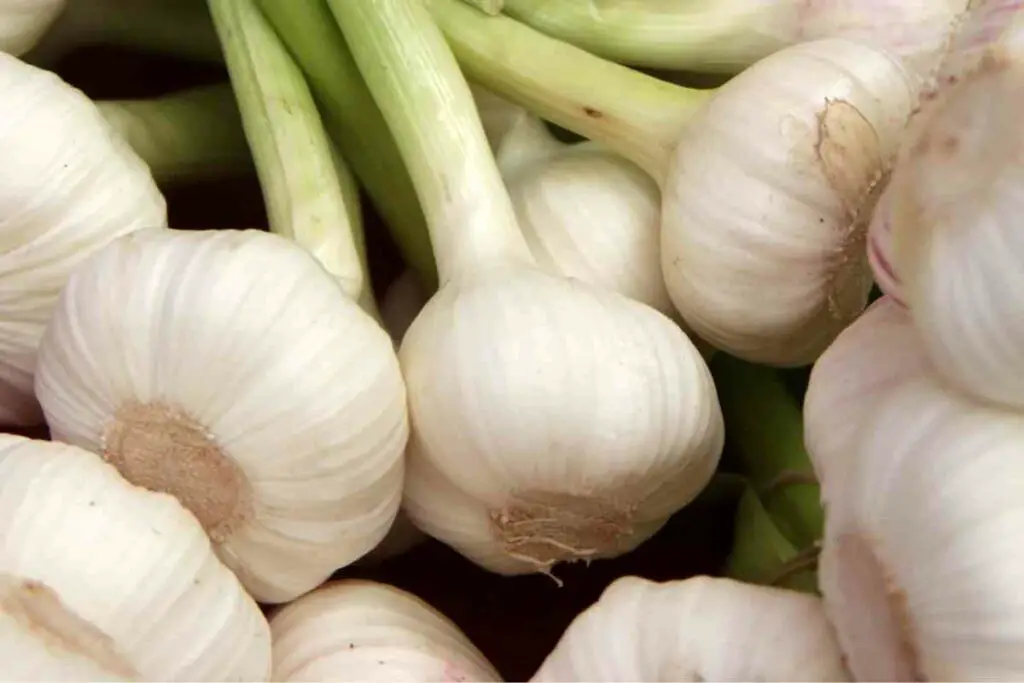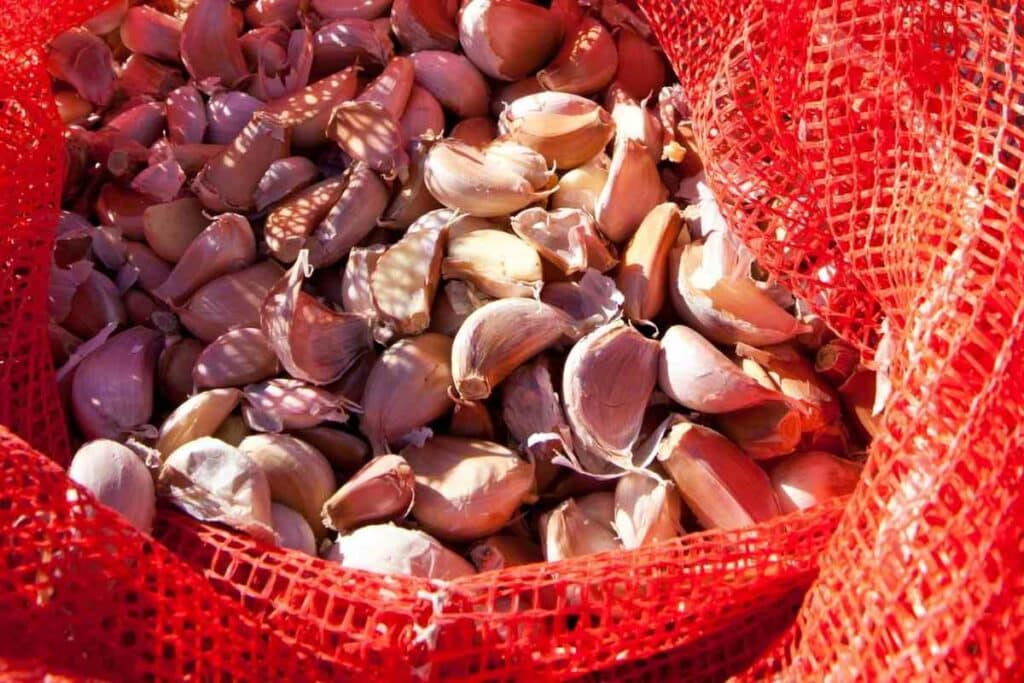Garlic is a herb that contains a wealth of health benefits. Planting and harvesting garlic is relatively simple if you know what to do.
Knowing when to harvest garlic can be tricky. If you pull out the bulbs early, you may have a premature harvest of small garlic.
Harvest too late, and the bulbs will be dry and cracking. However, the secret to a prime crop is in the leaves.
To determine whether garlic is ready for harvest, look at the color of the bottom leaves. Once they start to brown, harvest is near.
Garlic is an underground clove that can only be seen after harvest. Therefore, timing is everything. Read on to discover and learn how and when to harvest garlic.
How Many Varieties Of Garlic Are There?
Generally, garlic comes in two main varieties. However, there are tens of subspecies of garlic from the major ones.
Let’s have a quick look at some of the major varieties;
Softneck Garlic
Scientifically known as Allium sativum, softneck garlic is a product of hard neck garlic.
The main characteristic of this species is the soft stalks that grow above ground.

Sometimes people refer to it as braid garlic, a storage method only possible with the softneck variety.
Although they have a strong spicy flavor, the cloves are small and difficult to peel.
Additionally – They mature quicker than hardneck garlic and bring out more cloves per plant. Common types of softneck garlic are artichoke and silverskin cultivars.
These characteristics make them the best variety to grow for commercial purposes.
You will find softneck garlic more common in stores than the hardneck variety. An added advantage of softneck garlic is it lasts longer with easy storage.
Hardneck Garlic
Scientifically known as Allium stivum ophioscorodon, hardneck garlic has the most flavor of all garlic species.
Their stalks are firm, and although they have few cloves per plant, the bulbs are large.
Initially grown from wild garlic, the hardneck variety comes in various colors with a robust spicy flavor.

Peeling is easier due to their large size. The tall stems and flowering buds of hardneck garlic are known as garlic scapes.
Garlic scapes, which appear similar to wavy green beans, are edible. You can chop them into pieces to add to your salads and stir fry meals.
Most garlic farmers trim the stalks in summer to ensure the bulbs get all the nutrients.
Common types of hardneck garlic are:
- rocambole
- porcelain
- creole
- and the purple stripes variety
What Is The Best Time To Plant Garlic?
Garlic is best grown during the cold months of the year.
Farmers recommend anytime from October to early March.
This is best because garlic requires at least 30 days of cold to sprout new cloves.

However, planting them in different seasons will still produce good cloves. The only downside will be that they may not have the authentic look of the traditional plant.
The garlic may produce a single large clove when planted during warm seasons.
Although unusual, these potent flavor single cloves, such as the Kashmiri garlic, are popular in some areas.
When to Harvest Garlic
Garlic plants form bulbs at the beginning of warm weather.
Most varieties are ready to harvest in the warm months of June to the end of August.
However, harvest depends on the:
- planting time
- region
- and garlic variety
How do you know when garlic is ready to harvest?
Garlic takes between 8 to 9 months to get to full maturity. Some regions begin early harvest in May.
Surprisingly, hardneck garlic matures faster than softneck garlic varieties.

It’s essential to check your moisture levels and different stages of growth to best determine your harvest time.
The best way to tell when your garlic is ready for harvest is through the leaves:
- Once they start turning color, from green to yellow or light brown, start harvesting. The bottom leaves are what turn color and not the entire plant.
- Each leaf at the bottom of the plant represents the layer of skin on the bulb. If you harvest when most of the skin is intact, the garlic cloves will have more flavor and aroma.
- After all the leaves are brown, a late harvest means the cloves have less protection.
Therefore, they lose flavor and their potent fragrance. The extra cover also protects the bulbs from diseases and pests, lasting long on the shelf.
Hardneck garlic is ready to harvest when half the leaves are brown and the other half green.
For Softneck Garlic – Harvest once more than half the leaves are yellowish. Lift a few plants first to check the product before harvesting the entire field.
How to Harvest Garlic
There are several tips necessary to prepare your garlic garden for harvest.
They are:
- During planting, ensure you space your garlic plants correctly for easy harvest. Six inches between plants will prevent damage to the next plant during lifting.
- Keep watering the plants, even after the first leaves start yellowing and the stalks are limp.
- Once half the leaves turn color, stop watering around 7 days before harvest. Excess moisture when the bulb is ready can cause rot. Lifting the plants from the dry ground is also easier and cleaner.
To start harvesting, gather the tools you require.

You will need a garden fork, scissors, and a storage sack:
- Begin lifting the plant from below the roots. Loosen the soil around it using a garden fork to expose the root and gently pull it out. Be careful to prevent the fork from scratching the bulbs. Blemishes on the cloves will prevent them from lasting long.
- Hold the plant by the stalk and shake excess soil off it. If the bulb is still firm on the ground, do not forcefully pull it out. Use your fingers to hold the bulb and pry it out.
- Brush off any excess soil from the bulb but do not wash it. Moisture will introduce infections and rot to the cloves. Ensure the light skin on the bulb remains intact for an extra layer of protection.
- Cut out the roots and the top stalks to prepare the garlic for curing and storage.
- Sort the bulbs depending on the size and health of the cloves. Large healthy cloves are the best to replant in the next season as they produce a good crop.
- Pack what you require for use in the mesh storage bag. Alternatively, make a garlic braid using the soft stems of softneck garlic to hang in your kitchen.
Curing and storage of garlic
Do you have to cure garlic before eating?
You do not have to cure garlic. You can eat garlic immediately after harvesting. But what is curing garlic?

Curing garlic is hanging them in a cool, dry place to remove excess moisture. They also settle in flavor for extended storage.
Softneck garlic lasts for over 6 months in the dry open. In contrast, hardneck garlic lasts about 4 months under similar conditions.
If you want your hardneck garlic to last longer, store it almost to freezing point. The room should be naturally cold and not a refrigerator or cold room which introduces moisture.
Final Thoughts
Garlic is a must-have ingredient in your kitchen. Successfully growing and harvesting your herbs is highly fulfilling.
Ensure you harvest garlic at the right time for every crop you plant.
In case your first harvest is not as rewarding, keenly follow the tips shared above in the future. You will be an expert at garlic farming in no time.
